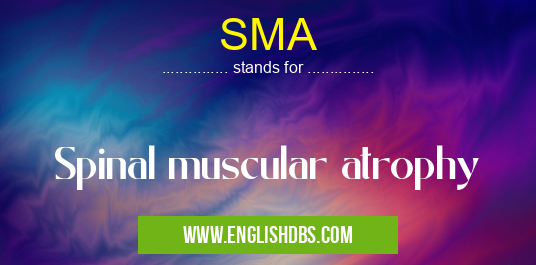What does SMA mean in THERAPY
Spinal muscular atrophy (SMA) is a genetic disease that affects the motor neurons in the spinal cord and brainstem. Motor neurons are nerve cells that control voluntary muscle movement. In SMA, these motor neurons are lost or damaged, which leads to muscle weakness and atrophy. SMA is a progressive disease, meaning that it gets worse over time.

SMA meaning in Therapy in Medical
SMA mostly used in an acronym Therapy in Category Medical that means Spinal muscular atrophy
Shorthand: SMA,
Full Form: Spinal muscular atrophy
For more information of "Spinal muscular atrophy", see the section below.
Symptoms of SMA
The symptoms of SMA can vary depending on the type and severity of the disease. However, some common symptoms include:
- Muscle weakness
- Muscle atrophy
- Difficulty breathing
- Difficulty swallowing
- Speech problems
- Scoliosis
- Joint contractures
Causes of SMA
SMA is caused by a mutation in the SMN1 gene. The SMN1 gene produces a protein called survival of motor neuron (SMN) protein. SMN protein is essential for the survival of motor neurons. When the SMN1 gene is mutated, it does not produce enough SMN protein, which leads to the loss or damage of motor neurons.
Types of SMA
There are four main types of SMA:
- Type 1 SMA: This is the most severe type of SMA. It typically begins in infancy and is characterized by profound muscle weakness and atrophy. Children with type 1 SMA often have difficulty breathing and swallowing, and they may not be able to sit or stand.
- Type 2 SMA: This type of SMA is less severe than type 1 SMA. It typically begins in early childhood and is characterized by muscle weakness and atrophy in the legs and arms. Children with type 2 SMA may be able to sit and stand, but they may have difficulty walking.
- Type 3 SMA: This type of SMA is the mildest type. It typically begins in late childhood or adolescence and is characterized by muscle weakness and atrophy in the legs. People with type 3 SMA may be able to walk, but they may have difficulty running or climbing stairs.
- Type 4 SMA: This type of SMA is very rare. It typically begins in adulthood and is characterized by muscle weakness and atrophy in the legs and arms. People with type 4 SMA may be able to walk, but they may have difficulty with balance and coordination.
Treatment for SMA
There is no cure for SMA, but there are treatments that can help to improve the symptoms of the disease. These treatments include:
- Physical therapy
- Occupational therapy
- Speech therapy
- Respiratory therapy
- Nutritional support
- Medications
Essential Questions and Answers on Spinal muscular atrophy in "MEDICAL»THERAPY"
What is spinal muscular atrophy (SMA)?
Spinal muscular atrophy (SMA) is a genetic disorder that affects the nerves that control voluntary muscle movement. It is caused by a mutation in the SMN1 gene, which is responsible for producing the survival motor neuron (SMN) protein. SMN protein is essential for the health and function of motor neurons, which are the cells that send signals from the spinal cord to the muscles. Without enough SMN protein, motor neurons die, leading to muscle weakness and atrophy (wasting).
What are the symptoms of SMA?
The symptoms of SMA can vary depending on the type and severity of the disorder. However, some common symptoms include:
- Muscle weakness in the arms, legs, and trunk
- Difficulty breathing and swallowing
- Tremors
- Scoliosis (curvature of the spine)
- Joint contractures (tightening of the joints)
- Muscle atrophy (wasting)
- Fatigue
- Slow growth
What are the different types of SMA?
There are four main types of SMA, classified according to the age of onset and severity of symptoms:
- Type 0: The most severe type, with symptoms beginning before birth or in the first few months of life.
- Type 1: Symptoms begin before 6 months of age, and infants are unable to sit or stand.
- Type 2: Symptoms begin between 6 and 18 months of age, and children are able to sit but not stand or walk.
- Type 3: Symptoms begin after 18 months of age, and children are able to walk but may have difficulty running or climbing stairs.
How is SMA diagnosed?
SMA is diagnosed through a combination of physical examination, medical history, and genetic testing. A blood test can be used to confirm the diagnosis by detecting the mutation in the SMN1 gene.
Is there a cure for SMA?
Currently, there is no cure for SMA, but there are several treatments available to manage the symptoms and improve quality of life. These treatments include:
- Medication to slow the progression of the disease
- Physical therapy to strengthen muscles and improve mobility
- Occupational therapy to help with daily activities
- Respiratory support
- Nutritional support
What is the prognosis for SMA?
The prognosis for SMA varies depending on the type and severity of the disorder. With early diagnosis and treatment, individuals with SMA can live full and active lives. However, the life expectancy for individuals with severe types of SMA is shorter.
Final Words: SMA is a serious disease that can have a significant impact on the lives of those who have it. However, there are treatments that can help to improve the symptoms of the disease and improve the quality of life for those who have it.
SMA also stands for: |
|
| All stands for SMA |
